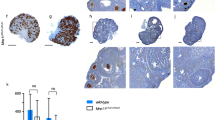Abstract
The cohesin complex is essential for chromosome segregation in mitosis and meiosis. Cohesin is a tripartite protein complex that holds sister chromatids together from DNA replication until anaphase. In mammals, meiotic DNA replication occurs in oogonia of embryos and chromosome segregation occurs in oocytes of sexually mature females. Sister chromatid cohesion establishment and chromosome segregation are thus separated by months in the mouse and decades in the human. The meiotic cohesin complex that maintains sister chromatid cohesion must therefore hold replicated sisters together for a long time in oocytes. Remarkably, this is achieved by establishing cohesion exclusively in prenatal oocytes. Meiotic cohesion in females is maintained without detectable turnover and cohesin is therefore thought to be a long-lived protein complex. Nevertheless, the lifespan of cohesin molecules is limited as chromosomal cohesin levels decline with maternal age. The age-related loss of cohesin and weakened cohesion correlate with an age-related increase in chromosome missegregation of meiosis I oocytes that results in aneuploid eggs. Therefore, loss of chromosomal cohesin has been proposed to be a leading cause of the maternal age effect. To better understand cohesin deterioration in oocytes, it is crucial to gain insights into mammalian cohesion establishment and maintenance mechanisms by manipulating cohesin in live oocytes.
This chapter describes techniques that address the manipulation of meiotic cohesin levels in mouse oocytes. First, we describe how cohesin can be efficiently removed from meiotic chromosomes by injecting mRNA encoding TEV protease in live oocytes expressing cohesin with engineered TEV recognition sites, followed by imaging. Secondly, we describe how cohesin expression can be induced during different stages of oocyte development using genetically modified mouse strains. In particular, we describe how to determine the deletion timing of germline-specific Cre recombinases using β-galactosidase staining of fetal ovaries. Lastly, we provide guidance on how to quantify cohesin levels on metaphase I chromosome spreads.
Access this chapter
Tax calculation will be finalised at checkout
Purchases are for personal use only
Similar content being viewed by others
References
Lima-De-Faria A, Borum K (1962) The period of DNA synthesis prior to meiosis in the mouse. J Cell Biol 14:381–388
Burkhardt S, Borsos M, Szydlowska A et al (2016) Chromosome cohesion established by Rec8-cohesin in fetal oocytes is maintained without detectable turnover in oocytes arrested for months in mice. Curr Biol 26:678–685
Tachibana-Konwalski K, Godwin J, van der Weyden L et al (2010) Rec8-containing cohesin maintains bivalents without turnover during the growing phase of mouse oocytes. Genes Dev 24:2505–2516
Lister LM, Kouznetsova A, Hyslop LA et al (2010) Age-related meiotic segregation errors in mammalian oocytes are preceded by depletion of Cohesin and Sgo2. Curr Biol 20:1511–1521
Chiang T, Duncan FE, Schindler K et al (2010) Evidence that weakened centromere cohesion is a leading cause of age-related aneuploidy in oocytes. Curr Biol 20:1522–1528
Tsutsumi M, Fujiwara R, Nishizawa H et al (2014) Age-related decrease of meiotic cohesins in human oocytes. PLoS One 9:e96710
Morton NE, Jacobs PA, Hassold T et al (1988) Maternal age in trisomy. Ann Hum Genet 52:227–235
Risch N, Stein Z, Kline J et al (1986) The relationship between maternal age and chromosome size in autosomal trisomy. Am J Hum Genet 39:68–78
Nybo Andersen AM, Wohlfahrt J, Christens P et al (2000) Maternal age and fetal loss: population based register linkage study. BMJ 320:1708–1712
Sakakibara Y, Hashimoto S, Nakaoka Y et al (2015) Bivalent separation into univalents precedes age-related meiosis I errors in oocytes. Nat Commun 6:7550
Kudo NR, Wassmann K, Anger M et al (2006) Resolution of chiasmata in oocytes requires separase-mediated proteolysis. Cell 126:135–146
Soriano P (1999) Generalized lacZ expression with the ROSA26 Cre reporter strain. Nat Genet 21:70–71
Acknowledgments
We are grateful to Paula Cohen for providing (Tg)Spo11-Cre mice, Philippe Soriano for Rosa26-LacZ mice and Nobu Kudo and Kim Nasmyth for providing (Tg)Stop/Rec8-myc mice. We thank Andrea Hirsch for technical assistance with meiosis I spreads.
Author information
Authors and Affiliations
Corresponding author
Editor information
Editors and Affiliations
Rights and permissions
Copyright information
© 2018 Springer Science+Business Media, LLC, part of Springer Nature
About this protocol
Cite this protocol
Szydłowska, A., Ladstätter, S., Tachibana, K. (2018). Manipulating Cohesin Levels in Live Mouse Oocytes. In: Verlhac, MH., Terret, ME. (eds) Mouse Oocyte Development. Methods in Molecular Biology, vol 1818. Humana Press, New York, NY. https://doi.org/10.1007/978-1-4939-8603-3_12
Download citation
DOI: https://doi.org/10.1007/978-1-4939-8603-3_12
Published:
Publisher Name: Humana Press, New York, NY
Print ISBN: 978-1-4939-8602-6
Online ISBN: 978-1-4939-8603-3
eBook Packages: Springer Protocols




